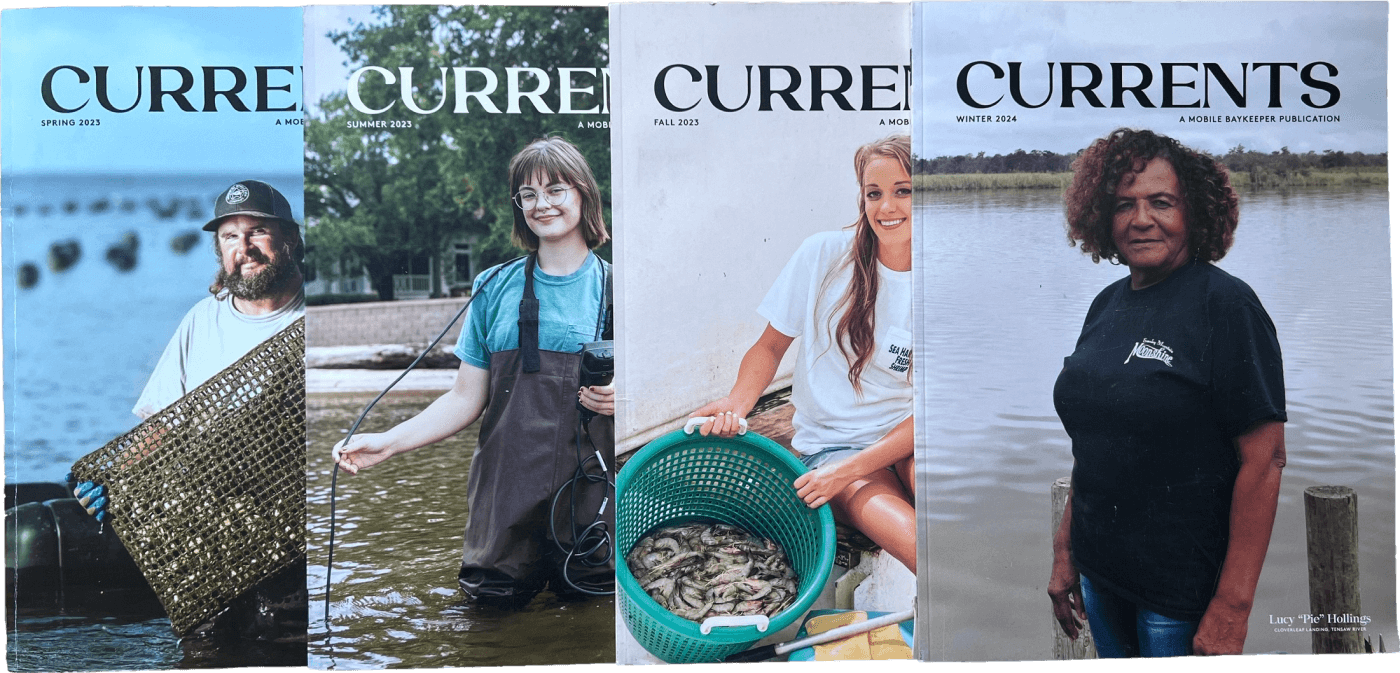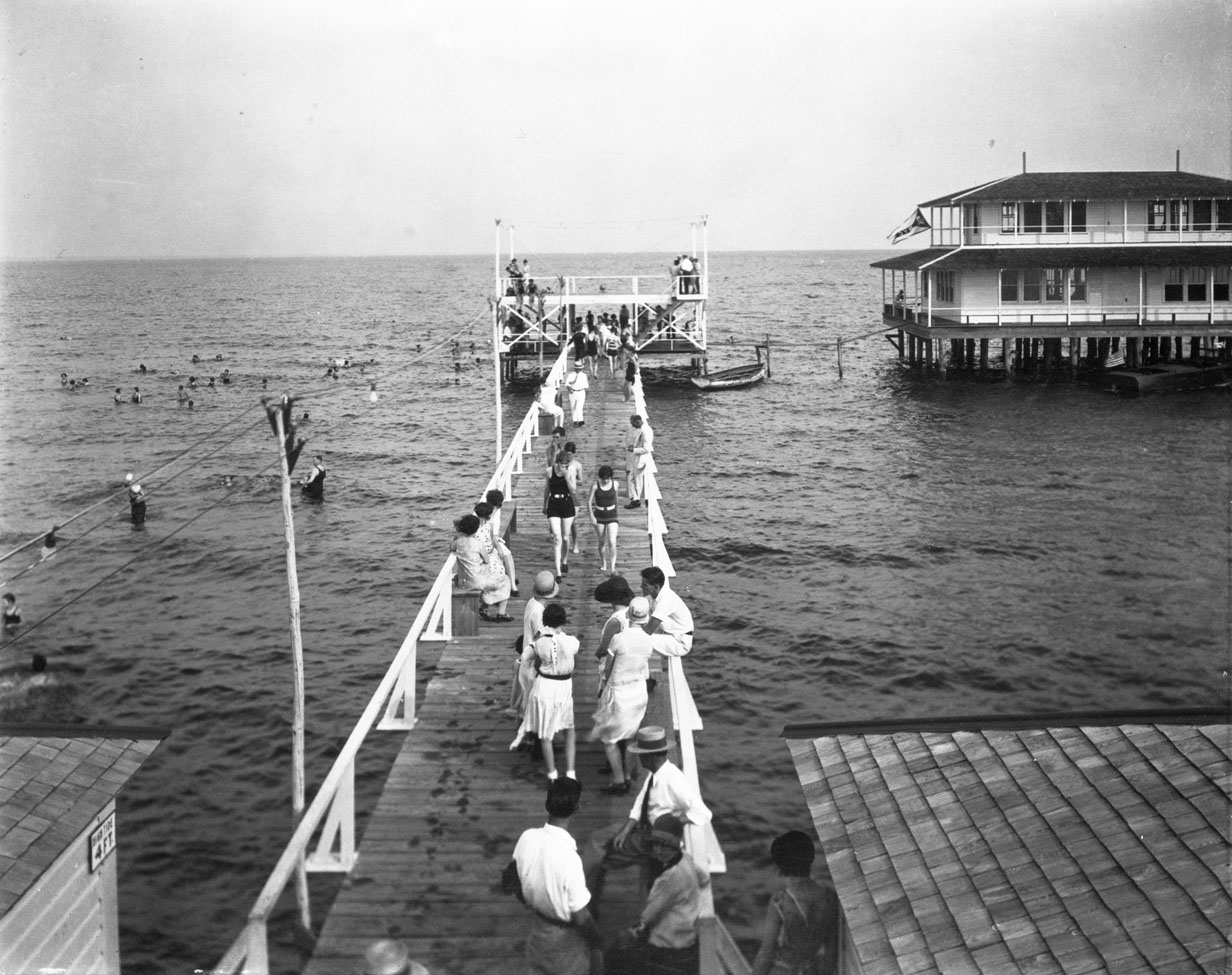
This article is from the winter edition of Mobile Baykeeper’s print quarterly, CURRENTS. The magazine is mailed to active members who have given more than $50 in the past year. To get on the magazine’s mailing list, donate here.
by Susan Rouillier
The Buccaneer Yacht Club, located on the western shore of Mobile Bay, was born of a passion for the sea and a thirst for adventure. In those early days, back when the world hadn’t forgotten the echoes of cannons and sights of steamboats, a group of hearty souls decided they needed a place to call their own — a place where the sea and the wind would be their companions. It was a time when men sported fedoras and women wore flapper dresses with bobbed hair. The world was trying to forget the chaos of World War I, and the sea, it seemed, whispered tales of freedom to those who would listen. In sultry, pre-air conditioned days, the waterfront, with its cool breezes, was the place to be.
BYC’s Founding
In the summer of 1928, four comrades (Leon Delaplaine, Foster Pfleger, John Mandeville, Ben Mayfield) united in a shared vision. They yearned for more than the mundane, and they found their escape in the creation of a formidable 30-foot, gaff-rigged cabin sloop. This vessel, christened the “Buccaneer,” became their sanctuary, a wooden haven where their spirits were set free upon the open waters of the Bay. Yachting fever coursed through their veins and the siren call of the sea had them in its grasp.
Soon, a daring notion gripped them. Why not form a brotherhood of sailors who shared their love for the wind-whipped waves? In the hazy days of July 1928, their audacious vision bore fruit.
The First Clubhouse at Barrett’s Beach
A charter was written, officers were elected, and the club was born. A clubhouse was needed because the club had progressed rapidly. In 1929, the club decided to purchase a site owned by Mr. W. J. Barrett, at Barrett’s Beach, a quarter of a mile north of Dog River on Mobile Bay. The first clubhouse was a two-story structure with “every modern convenience.” It was built by Mr. Barrett alongside a 1,000-foot pier. They flew a Jolly Roger flag on the club, a symbol of their pirate spirit, and they vowed to sail whenever they pleased. The club made rapid strides, and the covers featured on their new periodical, The Buccaneer Breeze, exuded a sense of sophistication ahead of its era.
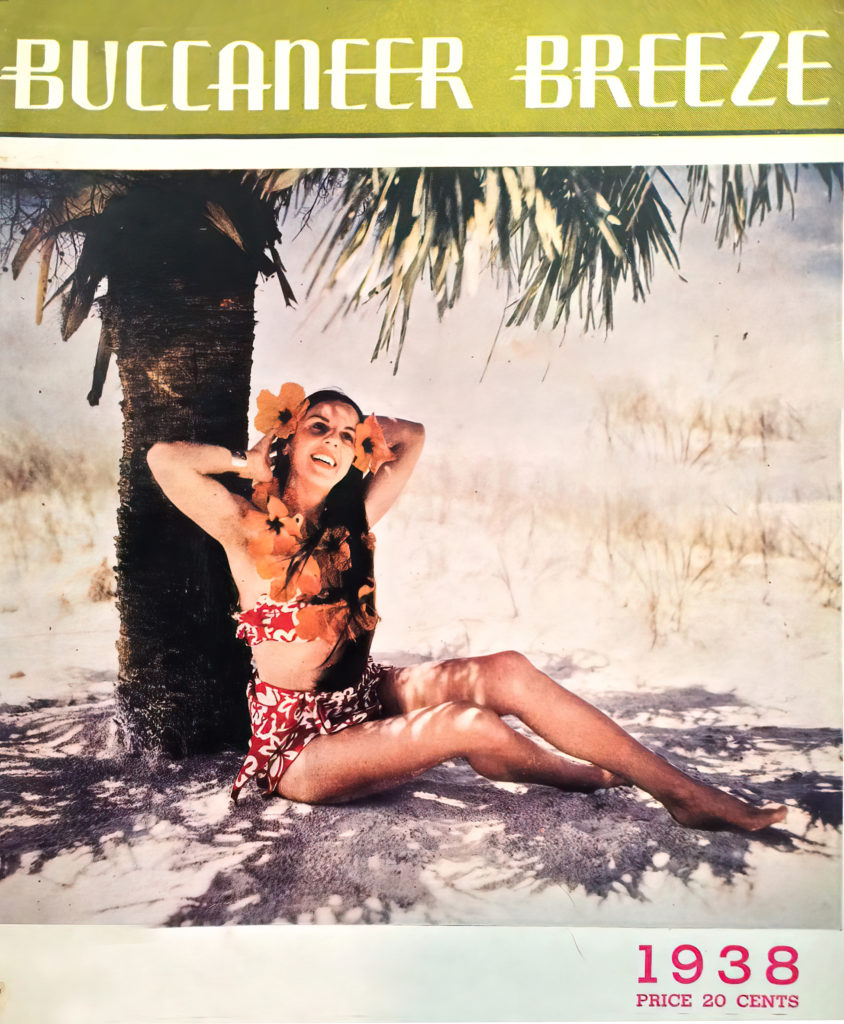
Races were held off Arlington Pier with a small fleet. The club also built three “fish class” boats — 21-foot, gaff-rigged sloops which competed for the magnificent silver trophy (the Lipton Cup) presented to the Gulf Yachting Association, by Sir Thomas Lipton, a British Tea magnate. Members of BYC also enjoyed and navigated the timeless Star class sailboat, a gaff-rigged keelboat revered as one of the foremost choices for competitive sailing. These two fleets, alongside catamarans and other sloops, offered exhilarating races characterized by a display of both excitement and mastery.
Unique in the World:
Second Clubhouse on Arlington Peninsula
“Remember the Resolute” has special meaning for all club members, because the Resolute was a four-masted cargo schooner built in 1902 that became the Buccaneer’s second clubhouse, one unlike any other in the world. The schooner was purchased by the Club in 1932 after it brought its final cargo of lumber to Mobile. The old ship’s masts were removed, it was positioned on land, and then converted into a clubhouse by its members. This poem portrays the significance that the venerable ship holds for its members.
Fast in a final mooring Life’s evening watch she stands. Yet all her beams are soaked with dreams — And these she understands: She knows the song of the vagabond waves, And each one tells of the shore it leaves. So does she — dreaming — live once more In many a port on some far-flung shore. And the dancing throng on her deck would seem The patter of workers’ feet in her dream. She hears the voice of the roving wind, And if it comes with hurricane din — Dreaming — she feels her timbers creak, And dreaming she springs a phantom leak, yet sturdy and proud, she knows her dream Will end where lights in her home port gleam. Fast in a final mooring Life’s evening watch she stands. Yet all her beams are soaked with dreams, And the Seven Seas she spans. Unknown author, Buccaneer Breeze (1935)
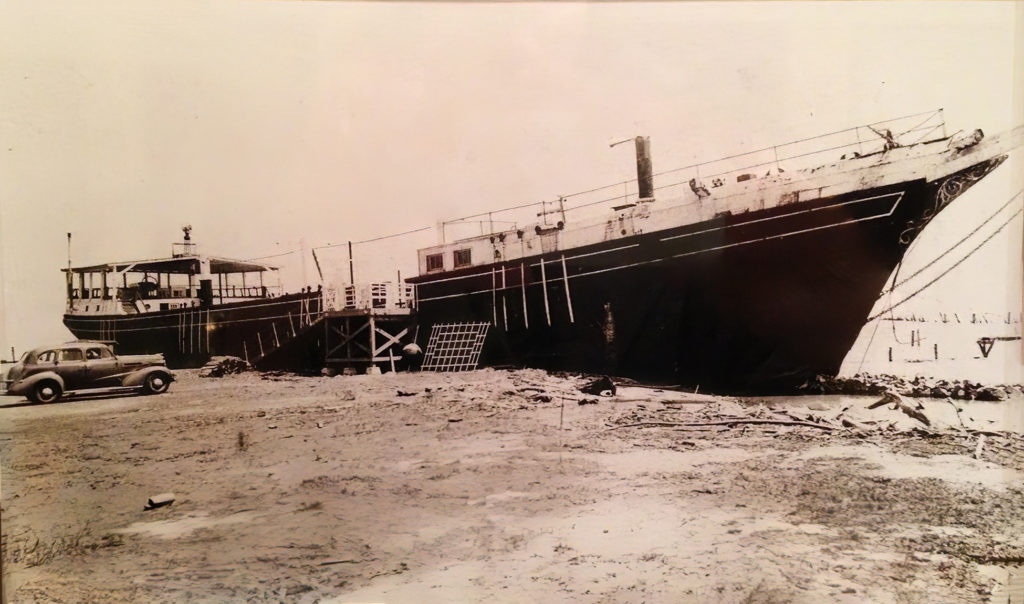
How to Place a 106-foot Schooner on Land Without a Crane
Springer Tam, the Club’s second Commodore, said: “The Resolute was towed down river and tied up alongside Arlington Pier. A dredge had dug a slip at the end of Arlington, and with her rock ballast removed, and at mean high tide, the ship was humped into the slip and made fast. Holes were bored in her hull to allow the water to flow in and out and create a suction to hold her fast in the sand.”
An oak dance floor was put down over the deck, and a roof garden and glassed-in enclosure finished the remodel of the ship, which now had the appearance of Noah’s Ark, and officially became the Buccaneer Yacht Club in May 1932, the only Yacht Club building of this type in the world.
Turtle Races and Dances
On the deck of their new clubhouse, BYC members relished the simple joy of turtle races, where a wire basket teeming with turtles descended into a circle, with the swiftest vying to reach its edge first.
Club members reveled in graceful dances within the luxurious confines of their freshly renovated clubhouse. An image of dancers, clad in sleek attire, seemed to embody a timeless elegance. Men with chiseled faces danced with women wearing silky, bias-cut gowns in the dimly lit embrace of the dance floor. Here, they relished big-band jazz playing in the background while they danced the Lindy Hop, Swing Dance, Waltz, or Foxtrot.
The Resolute clubhouse served its purpose for many years until the Army Air Corps requested use of it during World War II as a storage warehouse, and eventually purchased it outright. Today there is no remnant left of the Resolute Clubhouse and the site is now blocked and used as a storage place for buoys by the United States Coast Guard.
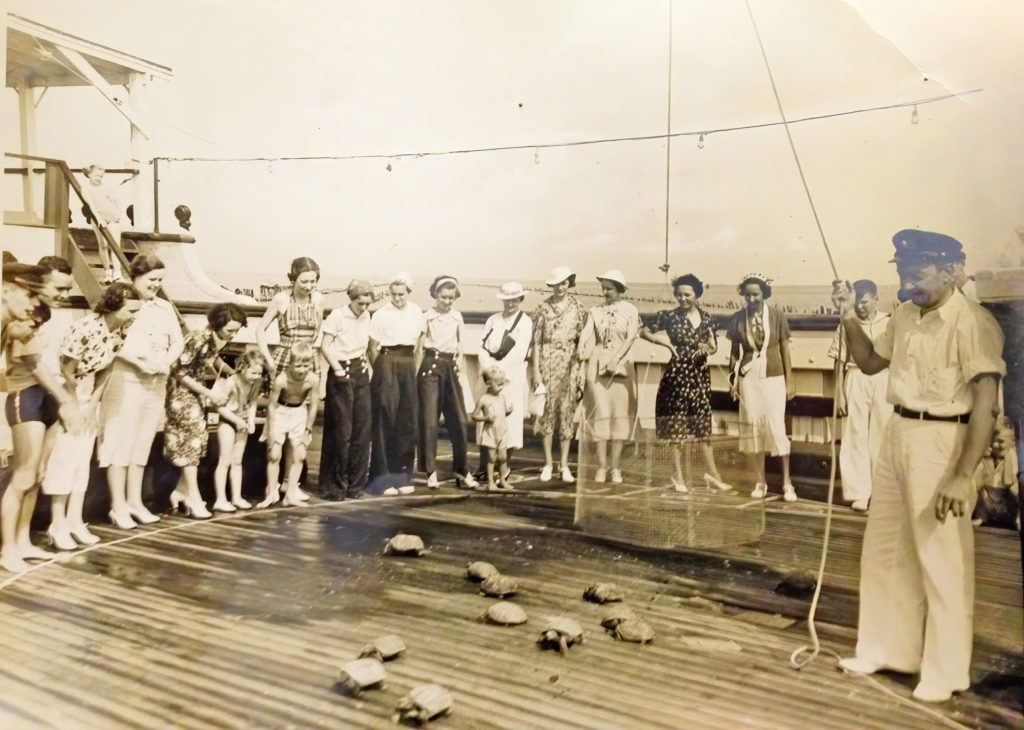
BYC’s Current Lodge
After World War II, a new clubhouse was needed. In 1947, the current clubhouse property, including McNally Park, was acquired on the former Foster’s Beach. Through dedicated member efforts over the years, the club has grown to encompass a clubhouse, harbor facilities, a bar, and a pool.
The club has endured challenges and celebrated successes. Its sailors became a close-knit family bonded by their love for the sea and enduring camaraderie. Nestled beneath mighty oaks and infused with the scent of the Bay, the Buccaneer Yacht Club, nearly a century old, stands as a testament to human determination and the spirit of adventure. In its historic clubhouse, echoes of its early days persist, recounting tales of pioneers, Hemingway-esque seafaring adventures, and the enduring bonds forged with the sea.
Members of the Buccaneer Yacht Club have upheld their motto “All for one and one for all” for more than 95 years. They take pride in promoting and participating in yachting and sailing in Mobile while educating the next generation of sailing enthusiasts. The club extends its reach into the community by sponsoring an annual Leukemia Cup Regatta and benefit, raising more than a half a million dollars for leukemia research and treatment.
Before moving to her current home on Mobile Bay, Susan Rouillier lived in Cuba, Japan, and Australia. She is the author of the South Mobile book series available on Amazon. www.susierou.com
Top image: Buccaneer Yacht club pier beside the first clubhouse at Barrett’s beach, 1920s. All images were shared by Kenny Kleinschrodt, Buccaneer Yacht Club historian. Quotes and information are from the Buccaneer Breeze magazine, a publication of the Buccaneer Yacht Club.
